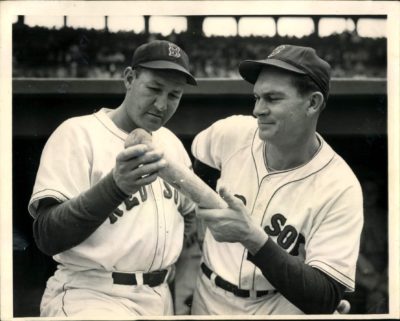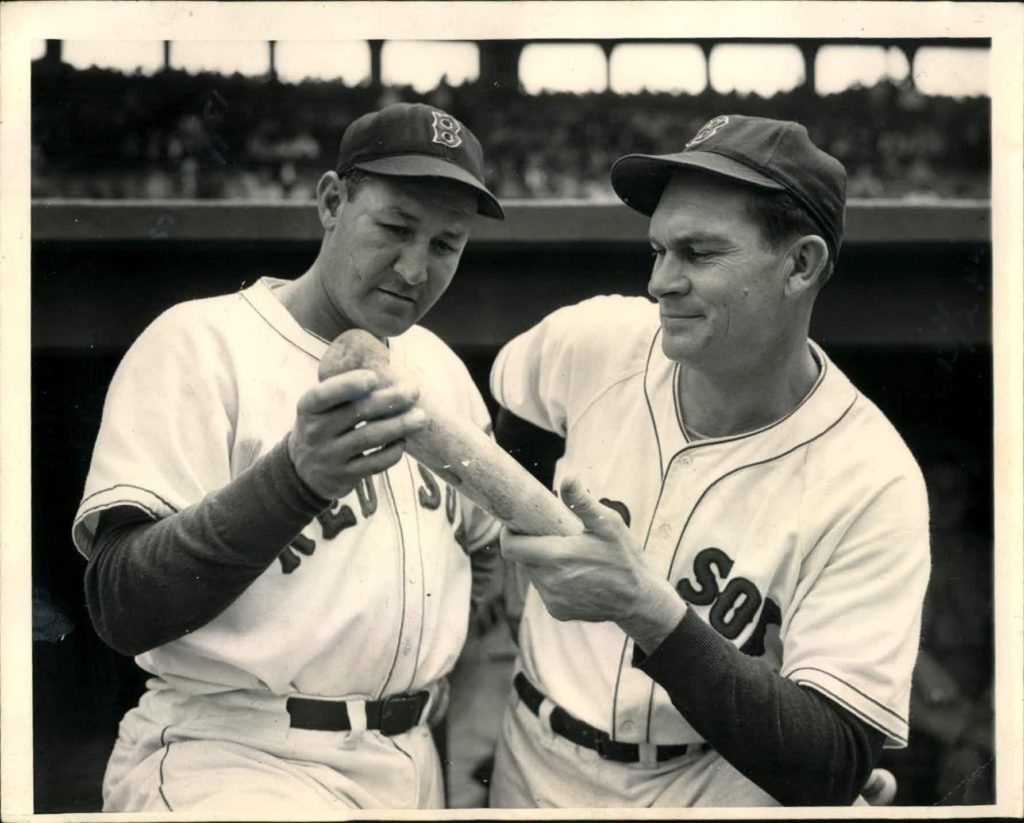Rudy York and the 1946 World Series Photo Gallery
Click on any image below to see photos in full size and to start Photo Gallery:

Attention Cub Fans: Read About Rudy York, the 1930-40’s Version of Kyle Schwarber!
If Kyle Schwaber has a career as good as Rudy York’s, I think Cub fans would be happy!
With one-eighth Cherokee ancestry and a severe liability with the glove, Rudy York was once described, in those pre-PC days of the 1930s, as: “Part Indian and part first baseman.”
This week marked the anniversary of a trade that worked out pretty good for the Red Sox. Seventy-one years ago this week, the Tigers traded Rudy York to the Red Sox for infielder Eddie Lake. York helped lead the Red Sox to the 1946 American League pennant, hitting .276 with 17 home runs and 119 RBI. In a losing cause, he also hit two important home runs homers in the 1946 World Series: a 10th-inning game-winner in Game One, and a three-run winner in the Game Three.
In the featured photo above, we see slugger Rudy York on left with Red Sox teammate Pinky Higgins.
The Ragland, Alabama native played 13 years in the major leagues (1934-48) with the Tigers (1934, ’37-’45), Red Sox (1946-’47), White Sox (1947), and Athletics (1948). Over his career, the seven-time all-star hit .275, with 277 home runs,1152 RBIs, 291 doubles, 52 triples, .362 on-base percentage, and .483 slugging average. His career OPS+ (123) places him well above average among contemporary major leaguers. He was a member of three pennant winners (1940, ’45, ’46) and one World Series championship (1945). In his three World Series appearances, he hit .221 with three homers and 10 RBI. His .503 slugging percentage as a Tiger ranks fourth in franchise history behind Hall-of-Famers Hank Greenberg, Harry Heilmann, and Ty Cobb; and his 239 home runs as a Tiger ranks seventh in franchise history. HIs career numbers place him in that nebulous category of: “Very good, but not quite Hall-of Fame calliber.”
A precursor to the Cubs’ Kyle Schwarber, York was the quintessential “good bat-no field” player. Unfortunately for Rudy, the designated hitter wasn’t part of the game back then. His career is summed up nicely in this quote:
“A slugger with a powerful bat, his managers tried time-after-time to find a position for him where he would do the least damage in the field. He was too awkward at third, too heavy footed for the outfield, extremely wild as a pitcher, and an immobile target as a catcher. From the beginning, though, he was a menacing figure with a bat and amazingly dangerous with the bases loaded: he hit 12 career grand slams, including two in a game.”
After a “cup of coffee” with the pennant-winning Tigers in 1934, and then two highly productive seasons in the minors, Rudy was back with the Tigers for the 1937 season as a first baseman. Since there was no room for a rookie first baseman on a team that already had Hank Greenberg, York started the season at third base but his defensive liabilities were just too great.That prompted a try in left field…and then ultimately to the bench.
In a last ditch effort to get his powerful bat into the lineup – reminding us of the Cubs’ efforts with Schwarber – manager Mickey Cochrane tried him as a catcher. Rudy responded well and went on to startle the baseball world. In August 1937, Rudy belted 18 home runs, surpassing the record of 17 set by Babe Ruth. He also collected 49 RBI breaking the mark set by Lou Gehrig. He finished his rookie season with a .307 batting average, 35 home runs, and 101 RBI in only 375 at bats.
After sharing catching duties with Birdie Tebbetts for two years, the Tigers persuaded Greenberg to switch from first base to left field in 1940, and moved York to first base, where it was thought he could do the least damage. The experiment was successful. Greenberg responded with a .340 average, with 41 home runs and 150 RBI, while York went .316, 33 and 134. The Tigers won the American League pennant, but fell to the Reds in the 1940 World Series, in which York hit .231, with one home run and two RBI.
In 1943 he had a career year, leading the league in home runs (34), RBI (118), total bases (301), extra base hits (67), slugging percentage (.527), and games played (154).
After his production fell off resulting in trades to the White Sox and Athletics, York’s playing days were over after the 1948 season. His post-playing baseball career included stints as a minor league manager, scouting for the Yankees and Colt .45s/Astros, hitting coach in the Red Sox’ minor league system, and four seasons (1959-62) as the Red Sox first-base coach. On July 3, 1959, he served as interim manager of the Red Sox for one game between Pinky Higgins‘ firing and the hiring of Billy Jurges.
Rudy York died in 1970 from cancer in Rome, Georgia, at the age of 56.
Gary Livacari
Photo Credits: All found on Google search
Information: Excerpts and quotes edited from the Rudy York Wikipedia page.
Subscribe to my blog for automatic updates and Free Bonus Reports: “Memorable World Series Moments” and “Gary’s Handy Dandy World Series Reference Guide.”

